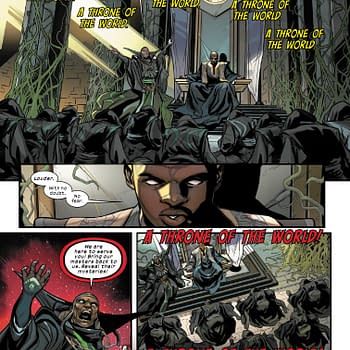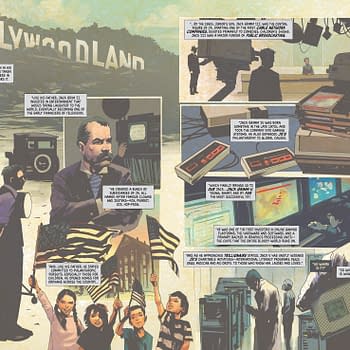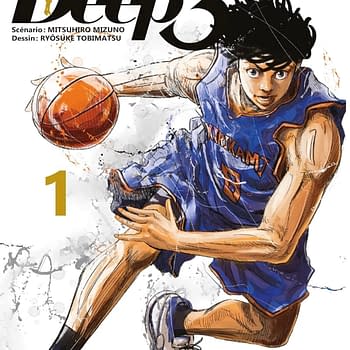Posted in: Comics | Tagged: Comics, dynamite, entertainment, Erik Mona, jonathan lau, Pathfinder: Worldscape
Writer's Commentary – Erik Mona Talks Pathfinder: Worldscape #2
A Writer's Commentary: Erik Mona talks Pathfinder Worldscape #2, on sale now from Dynamite. Cover by Reilly Brown and interiors by Jonathan Lau.

The title of the issue, "The Scepter and the Crown," refers to two potent magical artifacts central to the legend of the Worldscape dimension. We saw the Scepter in the hands of the evil immortal Empress Camilla in the first issue, and we'll get a glimpse at a replica of the Crown in the next issue. Tarzan, the near legendary "First King" of the Council of Jungle Kings, wears the genuine article. He'll appear later in the series. This issue introduces another Jungle King, Frank Frazetta's Thun'da, but I'm getting ahead of myself.
Let's take this page by page, or I may end up a thousand words in before I even start!
PAGE 1
Last issue followed the fighter Valeros on a solo adventure after appearing in the Worldscape without his allies. We left our hero in a rather precarious spot, but rather than tie up his fate, issue 2 leaves events in Shareen's arena aside and focuses instead entirely upon the sorcerer Seoni's emergence into the Worldscape.
We see Seoni awaken resting upon a fallen obelisk in a spooky jungle. The first panel shows the three linked circle glyph we last saw upon a similar obelisk in the Valeros story. Seoni recognizes the symbol, but as her magic comes from within rather than from study (contrary to that of her bookish—and very much absent—wizard companion, Ezren), she doesn't quite remember where she's seen it before. It was probably in one of Ezren's books.
Gorgeous two-page spread from artist Jonathan Lau. The composition here is borrowed from Roy Krenkel's cover for the Edgar Rice Burroughs novel "The Land of Hidden Men," in particular the 1963 Ace Books edition. Krenkel is one of my absolute favorite pulp paperback artists of the 60s, and here he's channeling original Tarzan artist J. Allen St. John (another favorite) to depict an amazing jungle scene. So on this spread we've got Lau channeling Krenkel channeling St. John. A pretty solid lineage.
The lion creature is, of course, Barsoom's 10-legged banth. It's tough to remember the number of legs creatures in Barsoom are supposed to have. Take a moment to do a Google image search for "banth" and count the legs. Folks get it wrong more often than they get it right.
Anyway, gorgeous panel.
PAGE 4-5
Seoni and the banth fight! Notice three "voks" in panel three as Seoni casts the spell "magic missile". That's a subtle Pathfinder rules-based hint that Seoni is either 5th or 6th level in this scene.
I really like Jonathan's panel of Seoni's face and hand as she casts her lightning bolt spell. Her friend, the wizard Ezren, debuted that spell in the previous series, Pathfinder: Hollow Mountain. In that scene, Seoni told him that he had to teach her the spell, which he presumably did.
Also, since sorcerers can't cast a third-level spell like lightning bolt until they're 6th level, this sequence firmly establishes that Seoni (and thus the rest of her Pathfinder companions) are 6th level during Pathfinder Worldscape, one level higher than they were in Hollow Mountain. In Pathfinder Worldscape #1, I provided game stats for Red Sonja that put her at 8th level, making her a bit more capable than our regular heroes. I'll likely end up putting John Carter, Tars Tarkas, and Tarzan at a similar level. Or possibly Tarzan will be much higher level, for reasons to be revealed as the series goes on…
This page was one of the earliest sequences I thought up for the issue, especially in how the thunder from Seoni's lightning bolt spell echoes over an establishing shot of the jungle. In the bottom half of the page, Jonathan Lau took a convoluted three-panel sequence in my script and turned it into this interesting composition—a vast improvement over what I had in my mind's eye.
PAGE 7
This page introduces my favorite character in Pathfinder Worldscape, and ironically she isn't associated with any of the four major licenses that comprise the team-up. When I was deciding on the roster of the team, Dynamite challenged me to add any public domain fantasy comics heroes to the roster, and I immediately thought of the character who first appears here—Fantomah!
Fantomah is considered by many historians to be the FIRST female comic superhero. In Pathfinder RPG terms she's probably more like a very high-level druid or even a demigoddess. She was created by Golden Age broken genius Fletcher Hanks, and I knew I needed to include her. Tarzan and Thun'da already brought significant jungle elements to the comic by default, so adding Fantomah—who appeared in 1940's Jungle Comics #1—was a great fit.
PAGE 8
Did I mention Fantomah turns blue, has a skull for a face, and is basically omnipotent?
Because Fantomah turns blue, has a skull for a face, and is basically omnipotent.
Her stories are all available free online, and you should definitely check them out. I posted a bit more about her on my blog at <LINK= http://www.erikmona.com/blog/2016/9/12/fantomah-lives-inside-the-weird-world-of-fletcher-hanks>erikmona.com</LINK>, so click through for some comics you will probably never forget.
PAGE 9
More interaction with Seoni and Fantomah. Note the reference to Thulgroon, the monstrous foe who appeared in the opening scene of Pathfinder Worldscape #1. The Pathfinders naturally think their monstrous foe (the chief villain of Jim Zub's Pathfinder: City of Secrets story arc) had something to do with sending them to the Worldscape, but Fantomah doesn't think so.
I agree with her.

PAGE 10
Seoni saying "Oh come on!" here is definitely a reference to escalating levels of bad in her very bad day, but naturally it's also a Buster Bluth reference from Arrested Development.
This page introduces Frank Frazetta's jungle hero, Thun'da, himself the star of a semi-recent Dynamite series. I read a ton of 1940s and 1950s jungle comics to prepare for this series and the Thun'da series—and especially the first issue written and illustrated by Frazetta—were among the best of the lot. I particularly appreciated Frazetta's original set-up, in which an American pilot crashes his plane in a remote African valley that features a time-lost world filled with dinosaurs and cave men. This allowed Frazetta to explore fun jungle tropes—fights against animals, lost cities, trees—without some of the nastier political and racial stereotypes that make reading vintage jungle comics such a chore in 2016. Of course, editors ruined that concept almost immediately, separating Thun'da from his "Dawn Land" and making him "King of the Congo," fighting off savage blacks just like all of the other jungle lords. Frazetta bailed on the book immediately thereafter.
For Worldscape, I pulled in Frazetta's Thun'da as well as the entire Dawn Land, which also provided the city of Shareen and the deposed queen Pha (Thun'da's girlfriend) from the first issue.
Jonathan Lau's illustrations blow me away on nearly every page, but for whatever reason, I think I like his depiction of Thun'da the best.
PAGE 11
Here we have the introduction of our next major character, the green Martian Tars Tarkas, best friend of John Carter (who appears in the next issue). The conversation between Seoni, Tars, and Thunda establishes a lot of the "rules" of the Worldscape dimension—who it pulls in, where they come from, etc.
PAGE 12
The three versions of Thun'da depicted here are, from left to right, the Bob Powell version that finished out the original Thun'da: King of the Congo comic after Frazetta left, the Jae Lee version from the recent Dynamite revival series, and Buster Crabbe, from the unfortunately EXTREMELY BORING "King of the Congo" serial from 1952. The idea of a guy named Roger Drum calling the name "Buster Crabbe" corny was one of the first things I came up with for the series. I'm probably the only person on the planet who thinks that's funny, but it makes me smile even thinking about it now.
This page also features the second close-up of a Pathfinder hero shaking hands with a legendary fantasy comics hero. Last issue it was Valeros and Pha. I didn't do this intentionally, but it'll happen at least a couple more times before the series is over.
I love Jonathan's drawing of Tars Tarkas at the bottom of this page.
Lots of talking on this page, but hey, the Worldscape is a complex place, and there is much information to share. Hooray to Jonathan for at least making it look fantastic.
The ruined city of Kor, mentioned here and appearing in the issue's final sequence, is a name lifted from another Thun'da comic. A recent discussion with Paizo's senior editor (and Burroughs expert) Christopher Paul Carey brought to my attention that Thun'da's writer (who was probably Gardner F. Fox) himself pulled the name of the city from another source, most likely as an homage. The original Kor is a lost city from H. Rider Haggard's classic 1886 fantasy novel "She." This is extremely ironic, because issue #4 coincidentally reveals that the titular character of that novel, Ayesha, is one of a handful of heroes to have ever "beat" the Worldscape by uniting the Secepter and the Crown (Tarzan, the near-legendary First King of the Council of Jungle Kings, is another).
The fourth panel on this page reveals that the three interlocked circles are the personal glyph of the archmage Nex, and that the obelisks that bring new warriors to the Worldscape are known as the Pillars of Nex. Nex is a personal creation of mine from the Pathfinder world, the architect of a mile-tall tower called the Spire of Nex, which is situated about a mile from the city of Absalom, the most important metropolis in the Pathfinder world.
In Pathfinder RPG terms, the Worldscape is a demiplane housed within the Spire of Nex on Golarion itself. I'll go into this more in Writer's Commentaries for future issues. It's really not important or necessary to understand the comic, so for now let's move on to other stuff.
PAGE 14
This page is my favorite image of the series so far, with fantastic work from Jonathan Lau and colorist Omi Remalante. I wanted this image to be jarring and a little bit disturbing, and these guys really delivered.
PAGE 15
Here we have our first reference to the TRUE villain of Pathfinder Worldscape: Kulan Gath. A long-time foe of Red Sonja, Kulan Gath was also the villain of the classic sword & sorcery/Marvel universe mash-up in Uncanny X-Men 190-191. Published in 1985, at the height of the popularity of D&D and early in my own venture into Marvel's merry mutants, this two-issue sequence was among the most formative of any comics I've ever read. I was thrilled to use Kulan Gath in the Worldscape series.
PAGE 16
Seoni asks Thun'da about Fantomah here because the bus driver's skull reminds her of Fantomah's hideous visage.
The skeletal children chase Seoni out of the bus, and she in turn casts the haste spell on her companions. This allows Thun'da to fire off five arrows in a single combat round (or, if you prefer, in a single panel), an event that seems to catch him by surprise.
PAGE 19-21
Here we see Empress Camilla's secret army, which is comprised of the simian scum of three worlds. Their leader is Ruthazek, Pathfinder's "Gorilla King." The character actually predates the launch of Paizo's Pathfinder brand, as he first appeared in a "generic" miniatures set entitled "Throne of the Gorilla King." When we created the Golarion world a few years later, we incorporated a few ideas from our pre-Pathfinder products, including Ruthazek.
PAGE 22
This final page lays bare Kulan Gath's ultimate plan to unite the Scepter and the Crown to open portals to Earth, Golarion, and Barsoom. From there, he will use Ruthazek's gorilla army to invade each of those worlds in turn.
Will it play out that way? Not if Tars Tarkas can make it to Shareen to warn "Jawn Kar-turr," but that's a tale for another day….
Erik Mona is the Publisher and Chief Creative Officer of Paizo, Inc. His comics credits include Pathfinder: Origins and Pathfinder: Hollow Mountain. You can follow him on Twitter @erikmona or visit his website at erikmona.com.


















